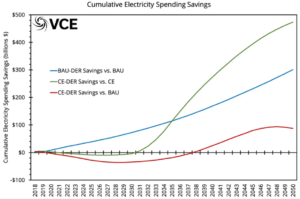This blog was authored by Steve Thrall, Vice President of Development – North America, eleXsys Energy
As the world continues to decarbonize and progress toward the “Electrification of Everything,” we should expect to see a 3-4x increase in local energy consumption. This means that not only will we progressively become more reliant on electricity in nearly all aspects of our lives, but having a safe, reliable, and carbon free grid will be even more critical.
 Adding more complexity to the Electrification of Everything transition is the realization that to achieve 100% renewables powered by wind and solar farms will require an expansive build out of transmission infrastructure. The US currently has about 200,000 miles of high-voltage transmission lines, with reports estimating that to achieve 100% renewables it would require doubling this amount, at a cost of ~$700 billion and taking at least 10 years. However, what often gets ignored is the valuable role that distributed energy resources (DERs) can play in the clean energy transition. Research has shown that the quickest and most cost-effective path to decarbonization is to maximize DER installations, which in turn also allows more centralized renewables to be interconnected.
Adding more complexity to the Electrification of Everything transition is the realization that to achieve 100% renewables powered by wind and solar farms will require an expansive build out of transmission infrastructure. The US currently has about 200,000 miles of high-voltage transmission lines, with reports estimating that to achieve 100% renewables it would require doubling this amount, at a cost of ~$700 billion and taking at least 10 years. However, what often gets ignored is the valuable role that distributed energy resources (DERs) can play in the clean energy transition. Research has shown that the quickest and most cost-effective path to decarbonization is to maximize DER installations, which in turn also allows more centralized renewables to be interconnected.
While it theoretically makes sense to maximize DER installations, the reality is that this is not without complexity. Consider for instance that our electricity grids have been fundamentally designed to have energy flow in one direction and yet, to capture the complete value of DER requires a two-way grid. Excess local generation needs to be exported, helping to power our local communities, and balancing the grid in the same ways that centralized renewables can but with the added benefits of being cheaper, faster, and providing greater resiliency. However, this two-way grid poses a physics challenge that grid engineers have long struggled to overcome with cost effective solutions. Generation exported onto the distribution network causes voltage rise and power quality issues, forcing network operators to curtail the amount of export or complete expensive distribution grid upgrades to contain voltage within statutory limits.\
Solving this problem has been the focus of eleXsys Energy, who nearly a decade ago began developing a device that would make it possible to quickly and cost-effective create a 100% two-way distribution grid. In doing so, eleXsys enables distant solar farms to be moved into the load centers and sited on large, empty rooftops, all without the need for expensive distribution grid upgrades and maximizing the value for customers, utilities, and society alike.
 Fast forward to today and they have achieved this at the world first IKEA eleXsys Microgrid in Adelaide, South Australia. eleXsys utilizes advanced power electronics and AI software to convert the traditional one-way distribution grid into a two-way distribution grid, cost effectively allowing DER generation to be shared amongst all network connected customers and enabling a paradigm shift in how our future electricity grids can operate.
Fast forward to today and they have achieved this at the world first IKEA eleXsys Microgrid in Adelaide, South Australia. eleXsys utilizes advanced power electronics and AI software to convert the traditional one-way distribution grid into a two-way distribution grid, cost effectively allowing DER generation to be shared amongst all network connected customers and enabling a paradigm shift in how our future electricity grids can operate.
This project serves to demonstrate that with a 100% two-way distribution grid requiring none or very little grid upgrades, it becomes possible to achieve the Electrification of Everything powered by local renewables, allowing the assets full value to be provided to the grid and excess clean energy to be consumed within our communities. Not only does this maximize the efficiency of our electricity networks by siting generation in the load centers but it also helps to keep electricity prices low and offers an equitable pathway for all customers to benefit from clean energy, not just those who can afford on-site renewables.


